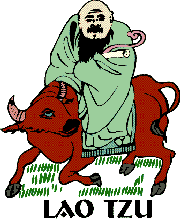
The TAO TE CHING is a classic work of Chinese philosophy and religion. It was written in the 4th/3rd century BC by Lao Tsu. Its most famous commentary is by CHUANG TZU (whose book is also referred to by the same name).
When presenting ancient Taoist thought in this course, I want to avoid the kind of academic discussion that would distract us from appreciating the contents. For simplicity's sake I will take for granted that the Tao Te Ching was written by the legendary Lao Tzu and the Nan Hua Chen Ching by Chuang Tzu. Even if some chapters were added later by disciples, they reflect the teaching of the masters.
Then there is the question of which version to use. Chinese idiom is short and pointed, but often hard to render in clear English. When quoting original passages, I offer my own free translation, which are partly based on the more literal, classical versions available, and partly on my own interpretation in the light of context and commentary. Being faithful to the mind of Chinese teachers requires more than literal renderings. It calls for a dynamic interpretation that makes sense to twentieth-century seekers.
More than forty translations exist of the TAO TE CHING. Among those I consulted are: L. Giles (Murray, London 1906); A. Wale (Macmillan, New York 1934); Lin Yutang (Modern Library, New York 1948); J.J.L. Duyvendak (Murray, London 1954); R.B. Blackney (Mentor, New York 1955); W. Chan (Bobbs-Merrill, Indianapolis 1963); D.C. Lau (Penguin, Harmondsworth 1963); G.F. Feng and J. English (Wildwood, London 1972).
The work of CHUANG TZU has been translated by: H.A. Giles, Chuang Tzu (Quaritch, London 1926); B. Watson, The Completc Works of Chuang Tzu (Columbia University Press, New York 1968); Y. Fung, Chuang Tzu (Commercial Press, Shanghai 1933); T. Merton, The Way of Chuang Tzu (New Directions, New York 1969; selections only). G.F. Feng and J. English, Chuang Tsu: Inner Chapters (Vintage, New York 1974).